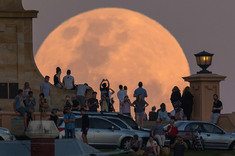By Hanneke Weitering, Space.com Staff Writer | February 11, 2018 09:30am ET Author Bio Hanneke Weitering, Space.com Staff Writer Hanneke joined the team at Space.com in August 2016 as a staff writer and producer. She’s a self-proclaimed science geek from the South with a passion for all things out of this world! She has previously […]
Tag Archives | space.com

Science and Sci-Fi at the Movies in 2017
There was plenty of science in the movies that hit screens large and small in 2017. Some films presented the stories of real people whose historic contributions to modern science were long hidden from public view. Others were set in a world and time much like the present one, but with some type of science […]
Biggest Full Moon of 2018 Shines in Spectacular New Year's Photos
Tyler S. Leavitt captured this image of the bright full moon in the cloudy Las Vegas sky on Jan. 1, 2018. Skywatchers got a glimpse of a spectacular full moon this New Year’s Day — the largest the moon will appear in 2018. Although the “biggest full moon of 2018” doesn’t look that different from […]
NASA Willing to Consider Flying Researchers on Commercial Suborbital Vehicles
NASA’s Flight Opportunities program is already flying experiments on Blue Origin’s New Shepard vehicle, but researchers and companies alike want NASA to also fund experiments with people on board. BROOMFIELD, Colo. — As commercial suborbital vehicles capable of carrying both payloads and people prepare to enter service, NASA officials say they’re willing to consider allowing […]
Mystery Solved? Gravity Waves Behind Jupiter's Weird Switching Jet Stream
The mystery of Jupiter’s strangely switching jet stream may have just been solved. Gravity waves are likely causing Jupiter’s jet stream to change direction, a new study suggests. The new results could reveal information not just about clouds in the atmospheres of planets in our own solar system, but also about those moving above the […]

January Full Moons 2018: See the 'Full Wolf Moon' and a Blue Moon, Too!
January is a very special month for lunar observers: The first month of 2018 will feature two full moons and a total lunar eclipse, or “blood moon.” New Year’s Day Full Moon: Are ‘Supermoons’ Really That Super? Full Wolf Moon: New Year’s Supermoon Is the Biggest of the Year Super Blue Blood-Moon 2018: When, Where and […]
First Blue Moon Total Lunar Eclipse in 150 Years Coming This Month
The moon turns blood-red in this image of a total lunar eclipse from 2004. A total eclipse of a “blue moon” will occur on Jan. 31, 2018. The first eclipse of 2018 will be a lunar one that comes at the very end of the month, on Jan. 31. It will be a total eclipse […]

New Year's Day Full Moon: Are 'Supermoons' Really That Super?
On this first day of 2018, at 5 p.m. EST (2200 GMT), the January full moon will arrive at perigee, its closest point to Earth in an orbit. Today, our lunar companion reaches an extreme perigee distance of 221,559 miles (356,565 kilometers). When these events coincide (a full moon at perigee), some people refer to the […]

Full Wolf Moon: New Year's Supermoon Is the Biggest of the Year
Editor’s Note: This story was updated at 12 p.m. E.T. New Year’s Day is a time for resolutions and hangovers, but this year, it also provides a chance to see the moon in all its glory. The first day of 2018 brings a “Full Wolf Moon” — the biggest of two supermoons that will rise […]
Angosat-1 Communications Restored After Post-launch Glitch
Angosat-1 seen prior to launch. GLASSBORO, New Jersey — Angola’s new satellite is communicating normally with ground teams again after losing contact shortly following launch. Moscow-based Energia, manufacturer of Angosat-1, as well as the Russian state corporation Roscosmos confirmed in press releases Dec. 29 that the satellite is sending telemetry and that onboard systems are […]
Message to the Gods: Space Poetry That Transcends Human Rivalries
This article was originally published at The Conversation. The publication contributed the article to Space.com’s Expert Voices: Op-Ed & Insights . Sputnik 1 started it all. The beachball-sized satellite was launched by the Soviet Union on October 4, 1957 and, despite a relatively short mission of only 21 days in orbit around Earth, quickly became […]
When, Where and How to See the Planets in the 2018 Night Sky
This is a spectacular year for Mars . On July 31 at 3:50 a.m. EDT, the planet will come closer to Earth than at any other time since its historically close approach of August 2003. Its distance from Earth at that moment will be 35.78 million miles (57.59 million kilometers). Not until September 2035 will […]

Full Moon Names 2018: From Wolf Moons to Cold Moons
Each year since 2004, Space.com has provided a listing of full moon names that date back to a few centuries ago, when Native Americans occupied the region that’s now the northern and eastern United States. Those tribes of long ago kept track of the seasons by giving distinctive names to each recurring full moon. Their […]